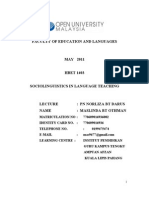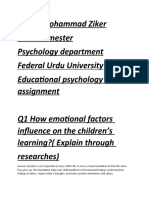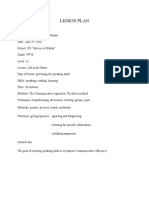JJJJJJJJJJJJJJJJJJJJJJJJJJJJJJ
JJJJJJJJJJJJJJJJJJJJJJJJJJJJJJ
Uploaded by
Jonätän PMCopyright:
Available Formats
JJJJJJJJJJJJJJJJJJJJJJJJJJJJJJ
JJJJJJJJJJJJJJJJJJJJJJJJJJJJJJ
Uploaded by
Jonätän PMCopyright
Available Formats
Share this document
Did you find this document useful?
Is this content inappropriate?
Copyright:
Available Formats
JJJJJJJJJJJJJJJJJJJJJJJJJJJJJJ
JJJJJJJJJJJJJJJJJJJJJJJJJJJJJJ
Uploaded by
Jonätän PMCopyright:
Available Formats
JJJJJJJJJJJJJJJJJJJJJJJJJJJJJJ
Basic Format for Books Author, A. A. (Year of publication). Title of work: Capital letter also for subtitle. Location: Publisher. Note: For "Location," you should always list the city and the state using the two letter postal abbreviation without periods (New York, NY). Calfee, R. C., & Valencia, R. R. (1991). APA guide to preparing manuscripts for journal publication. Washington, DC: American Psychological Association. http://owl.english.purdue.edu/owl/resource/560/08/
King County Library (free) http://www.kcls.org
Do not scroll down, look for the image that matches the attachment. It will be on the right side of the page. Seattle Public Library (free): http://www.spl.org Do not scroll down, look for the image that matches the attachment. It will be on the left side of the page. You can also try the Minneapolis Public Library (free): https://catalog.hclib.org/ipac20/ipac.jsp?profile=elibrary#focus The Keyword search option appears in the middle of the page (see the attachment). THE library in the USA that has all titles available (located in Washington DC) is the Library of Congress where you can select "library catalogs" or "ask a librarian" free of charge. Best of luck on your searches!
We all want to feel cared for and valued by the significant people in our world. Students are no different. This knowledge is a powerful tool in the arsenal available to you as you form your classroom discipline plan. As a classroom teacher, you wield a great deal of power over your students simply due to the fact that you control their destiny for up to six and a half hours each day, five days a week. When students feel that you value and care for them as individuals, they are more willing to comply with your wishes. Think about it for just a minute. Aren't you more apt to go out of your way to please a boss who you feel values you as an individual and treats you with dignity and respect, rather than a boss who communicates a lack of respect for you? When your boss asks about your family, gives you slack when there is a personal emergency, or praises you for work well done, don't you develop feelings o f regard for this boss and want to do your best to please him or her? Students have the same feelings. So it makes sense that developing positive teacher-student relations is one of the most effective steps you can take to establish a positive discipline climate in the classroom. It's critical to remember that when you treat students with respect, they tend to appreciate and like you. When they appreciate and like you, they are more willing to want to please youwhich causes them to be more likely to behave appropriately. This is why it is so important to remember that, when it comes to student behavior, it's far more often the relationship students have with you than it is the rules themselves that encourages students to follow those rules. A review of the research shows that authors have a lot to say about positive relationships with students. Thompson (1998) says, The most powerful weapon available to secondary teachers who want to foster a favorable learning climate is a positive relationship with our students (p. 6). Canter and Canter (1997) make the statement that we all can recall classes in which we did not try very hard because we didn't like our teachers. This should remind us how important it is to have strong, positive relationships with our students. Kohn (1996) goes a step further, saying, Children are more likely to be respectful when important a dults in their lives respect them. They are more likely to care about others if they know they are cared about (p. 111). Marzano (2003) states that students will resist rule s and procedures along with the consequent disciplinary actions if the foundation of a good relationship is lacking. He goes on to assert that relationships are perhaps more important at the elementary and junior high levels than at the high school level. And according to Zehm and Kottler (1993), students will never trust us or open themselves up to hear what we have to say unless they sense that we value and respect them. As we showed in Figure S1, strategies to develop positive teacher-student relations should be the largest portion of your discipline plan. What are some strategies that you can implement to develop strong and powerful relationships with your students? Let's look at some techniques that are easy to integrate into your everyday interactions with students: communicating positive expectations, correcting
students in a constructive way, developing positive classroom pride, demonstrating caring, and preventing and reducing your own frustration and stress.
Teaching interactions The teacher of small class was able to stay with one small group (who she felt needed her help) for more ir less the whole session, they recived sustained attention and she was able to offer immediate feedback. Task allocation and preparation was very deliberate, responsive and individualized; she went through each person in turn and asked what they wanted to do from a list of activities and she then set them off. Knowledge of children The teacher felt that the main advantage of having a small class was that she knew children individually , and that these informed her teaching, for example in terms of questions to children, she was aware of who knew and did not know something. Support for learning The teacher feel very strongly that hearing children of this age read individually in school was important. The small class allowed almost daily session in which there was a stress on individualized support this crucial time in childrens reading. This would not be possible in a large class.
Small-Group Learning Much of the work involving inquiry-based learning involves students working in pairs or groups to solve a problem, complete a project, or design and build an artifact. Cooperative small-group learning, which Cohen (1994b) defines as students working together in a group small enough that everyone can participate on a collective task that has been clearly assigned, has been the subject of hundreds of studies and several meta-analyses (Cohen, Kulik, & Kulik, 1982; Cook, Scruggs, Mastropieri, & Castro, 1985; Hartley, 1977; Johnson, Maruyama, Nelson, & Skon, 1981; Rohrbeck, Ginsburg-Block, Fantuzzo, &
Miller, 2003). Overall, these analyses come to the same conclusion: there are significant learning benefits for students who work together on learning activities (Johnson & Johnson, 1981, 1989). For example, in a comparison of four types of problems presented to individuals or cooperative teams, researchers found that teams outperformed individuals on all types and across all ages (Quin, Johnson, & Johnson, 1995). Problems varied in terms of how well defined they were (a single right answer versus open-ended projects, such as writing a story) and whether they were more or less reliant on language. Several experimental studies have shown that groups outperform individuals on learning tasks and that individuals who work in groups do better on later individual assessments as well (Barron, 2000a, b; 2003; ODonnell & Dansereau, 1992). Cooperative group work benefits students in social and behavioral areas as well, including improvement in student selfconcept, social interaction, time on task, and positive feelings toward peers (Cohen et al., 1982; Cook et al., 1985; Hartley, 1977; Ginsburg-Block, Rohrbeck, & Fantuzzo, 2006; Johnson & Johnson, 1989). GinsburgBlock and colleagues (2006) focused on
the relationship between academic and nonacademic measures. They found that both social and self-concept measures were related to academic outcomes. Larger effects were found for classroom interventions that used same-gender grouping, interdependent group rewards, structured student roles, and individualized evaluation procedures. They
222222222222222 2. The role of classroom interaction in communicative language teaching Probably the most common view of the role of classroom interaction in the profession currently is the somewhat narrowly 'methodological' one that proposes that classroom interaction contributes to language development simply by providing target language practice opportunities. Through carefully designed classroom interaction activities, involving various forms of more or less 'realistic' practice, learners can become skilled at actually doing the things they have been taught about (turning 'knowledge that' into 'knowledge how'). This view, taking account as it does only of classroom interaction in the target language, is essentially the position of advocates of the standard model of communicative language teaching over the last two decades. Littlewood's highly influential 1981 volume on communicative language teaching will be taken here to represent this mainstream viewpoint. In 1981 Littlewood advocated a progression from3 'pre-communicative' to 'communicative' activities involving various forms of interactive language practice. His underlying view of the psychology of language learning was that
systematic language practice is crucial, as it was in the otherwise discredited behaviourist model of learning. But he also believed that practice should progressively emphasize relevance over repetition. That is to say, that practice activities should progressively come closer and closer and closer to imitating 'real-life' language use (a feature also found, it might be noted, if in a less developed form, in the work of such 'behaviourist' writers as Lado (1964)). The general notion of 'negotiation' (loosely defined as 'discussion to reach agreement') will be involved, therefore, only if 'negotiation' is itself seen as a type of 'real-life' language use that is relevant to the learning purposes of the learners. This is most likely to be the case in the context of a course of 'business English', say, or 'English for diplomats', where 'negotiation' can be expected to be identified as a relevant target language skill for the learners to develop in the classroom, through simulated negotiations. I hope it is already clear that such a concept of 'negotiation' - as a target language skill to be practised through simulations in classroom interaction - is a purely 'methodological proposal' that is conceptually a very long way away from the notion of 'negotiated work' that is the central concern of this present volume. It is for this reason that I propose to reject the standard form of communicative language teaching as interesting for our present purposes, in spite of its manifest interest in the promotion of classroom interaction, and to move on to the other two views on the contribution of classroom interaction to language development.
You might also like
- Final BibltranDocument9 pagesFinal Bibltranapi-335914096No ratings yet
- Edfd260 Assignment 2Document9 pagesEdfd260 Assignment 2api-252779423No ratings yet
- Enhancing The Reading Ability of The 10 Quite Non-ReadersDocument19 pagesEnhancing The Reading Ability of The 10 Quite Non-ReadersKathreen Barazon HilayNo ratings yet
- Osins Educational Foundation Inc. Balaoan, La UnionDocument18 pagesOsins Educational Foundation Inc. Balaoan, La UnionFebz CanutabNo ratings yet
- Ask Questions and Care About Answers. Markham, Ontario, CanadaDocument4 pagesAsk Questions and Care About Answers. Markham, Ontario, Canadaapi-314551798No ratings yet
- Final Annotated BibliographyDocument12 pagesFinal Annotated Bibliographyapi-404804386No ratings yet
- Asg Sociolinguistics PN NolizaDocument12 pagesAsg Sociolinguistics PN NolizaMas MaslindaNo ratings yet
- Cooperative LearningDocument19 pagesCooperative LearningIsaiyasNo ratings yet
- ED579279Document13 pagesED579279itadori yuujiNo ratings yet
- Literature Review Classroom EnvironmentDocument4 pagesLiterature Review Classroom Environmentbzknsgvkg100% (1)
- Bobbette, Morgan Teaching Cooperative Learning With Children Literature NFTEJ V22 N3 2012Document12 pagesBobbette, Morgan Teaching Cooperative Learning With Children Literature NFTEJ V22 N3 2012davidput1806No ratings yet
- Portfolio Annotated BibliographyDocument9 pagesPortfolio Annotated Bibliographyapi-438615530No ratings yet
- Assignment No 3 B.edDocument37 pagesAssignment No 3 B.edlena loniNo ratings yet
- Combining Cooperative Learning With Reading Aloud by TeachersDocument22 pagesCombining Cooperative Learning With Reading Aloud by TeachersAhleia Gia SaliganNo ratings yet
- Teaaching EnglishDocument26 pagesTeaaching EnglishLice CorNo ratings yet
- Annotated Bibliography - DavisDocument9 pagesAnnotated Bibliography - Davisapi-556470599No ratings yet
- Words. Retrieved From: Reminding-And-RedirectingDocument4 pagesWords. Retrieved From: Reminding-And-Redirectingapi-349059441No ratings yet
- Creating A Motivating Classroom EnvironmentDocument7 pagesCreating A Motivating Classroom EnvironmentdooblahNo ratings yet
- The Instructional Conversation Teaching and Learning in Social ActivityDocument10 pagesThe Instructional Conversation Teaching and Learning in Social ActivityRev. Tet GallardoNo ratings yet
- Classroom Management PlanDocument21 pagesClassroom Management Planapi-207677771No ratings yet
- Annotated Bibliography Final DraftDocument13 pagesAnnotated Bibliography Final DraftkivrajNo ratings yet
- OMM1 TASK 1_ CREATING A SUPPORTIVE LEARNING ENVIRONMENT_LeahShawDocument8 pagesOMM1 TASK 1_ CREATING A SUPPORTIVE LEARNING ENVIRONMENT_LeahShawleahshawNo ratings yet
- Annotated BibliographyDocument8 pagesAnnotated BibliographykivrajNo ratings yet
- Effective Teaching Strategies in Social StudiesDocument10 pagesEffective Teaching Strategies in Social StudiesTiffany Jones100% (1)
- Step 2: Academic Paper - 1st DraftDocument5 pagesStep 2: Academic Paper - 1st DraftkivrajNo ratings yet
- Daily Reflection JournalDocument5 pagesDaily Reflection Journalapi-302347626100% (1)
- Ed 698 - Annotated BibliographyDocument15 pagesEd 698 - Annotated Bibliographyapi-518329822No ratings yet
- Improving Reading Skills ThroughDocument8 pagesImproving Reading Skills ThroughKanwal RasheedNo ratings yet
- Ed 6463-RF-syllabus-Winter '20Document12 pagesEd 6463-RF-syllabus-Winter '20atena golmohammadiNo ratings yet
- Cycle 2-Annotated Bibliography 1Document4 pagesCycle 2-Annotated Bibliography 1api-343815626100% (1)
- Independent Learning Literature Review 2008Document5 pagesIndependent Learning Literature Review 2008aflsmceoc100% (1)
- Module 5 Developing Interpersonal SkillsDocument7 pagesModule 5 Developing Interpersonal SkillsluckyjennysmithNo ratings yet
- Final Annotated BibliographyDocument10 pagesFinal Annotated Bibliographyapi-301639691No ratings yet
- Annotated Bibliography Final DraftDocument13 pagesAnnotated Bibliography Final Draftkivraj100% (1)
- Cooperative Learning: Making "Groupwork" WorkDocument15 pagesCooperative Learning: Making "Groupwork" WorkSharon ForeroNo ratings yet
- READINGDocument8 pagesREADINGArmina GuiamalonNo ratings yet
- Untitled DocumentDocument5 pagesUntitled Documentapi-250939230No ratings yet
- Bib Layout This OneDocument7 pagesBib Layout This Oneapi-545979968No ratings yet
- Basma Abdulla Role of Innate Ability and Environment in FLA and SLADocument7 pagesBasma Abdulla Role of Innate Ability and Environment in FLA and SLABasma AbdullaNo ratings yet
- Annotated BibliographyDocument3 pagesAnnotated Bibliographyapi-317160684No ratings yet
- Annotated Bibliography PortfolioDocument14 pagesAnnotated Bibliography Portfolioapi-722424133No ratings yet
- NVCDocument9 pagesNVCapi-283921424No ratings yet
- Philosophy of Education You Were Educated inDocument5 pagesPhilosophy of Education You Were Educated innicole mirandaNo ratings yet
- Lessons From Good Language Learner Part17 Chapter13Document11 pagesLessons From Good Language Learner Part17 Chapter13MegabiteUQNo ratings yet
- Literature Review Early Childhood EducationDocument10 pagesLiterature Review Early Childhood Educationafmzzulfmzbxet100% (1)
- What Is The Purpose of Education in Our Society 1Document4 pagesWhat Is The Purpose of Education in Our Society 1api-333548601No ratings yet
- My Teaching PhilosophyDocument6 pagesMy Teaching Philosophyapi-361083998No ratings yet
- Don T Give UpDocument7 pagesDon T Give UpchristinaschoNo ratings yet
- Major Theories and ThemesDocument6 pagesMajor Theories and ThemesHayles RoganNo ratings yet
- Educational Psychology Assignmnt..........Document8 pagesEducational Psychology Assignmnt..........Maria ZikerNo ratings yet
- Annotated Bibliography StartDocument14 pagesAnnotated Bibliography Startapi-547381170No ratings yet
- Task 2: Academic WritingDocument5 pagesTask 2: Academic WritingLiving LegacyNo ratings yet
- Angelie RRLDocument11 pagesAngelie RRLJohn BadangNo ratings yet
- Cooperative Approaches To Language LearningDocument3 pagesCooperative Approaches To Language LearningMostaq AhmedNo ratings yet
- Annotated BibliographyDocument13 pagesAnnotated Bibliographyapi-295669671No ratings yet
- Annotated BibliographyDocument8 pagesAnnotated Bibliographyapi-351587400No ratings yet
- Johnson, R. T., & Johnson, D. W. (1986) - Cooperative Learning in The Science Classroom. Science and Children, 24, 31-32 PDFDocument2 pagesJohnson, R. T., & Johnson, D. W. (1986) - Cooperative Learning in The Science Classroom. Science and Children, 24, 31-32 PDFHam Daz100% (2)
- MODULE 2Document13 pagesMODULE 2michael manaladNo ratings yet
- Humanizing Classroom Management: Restorative Practices and Universal Design for LearningFrom EverandHumanizing Classroom Management: Restorative Practices and Universal Design for LearningNo ratings yet
- Asian College of Teachers: Diploma AssignmentDocument18 pagesAsian College of Teachers: Diploma AssignmentAnjali Tigga67% (3)
- Poster XXDocument1 pagePoster XXRatih SoeronoNo ratings yet
- What Is The Role of Materials in Language TeachingDocument2 pagesWhat Is The Role of Materials in Language TeachingDavid Rayner Sipilis Motius86% (7)
- 7 Providing For Effective TeachingDocument55 pages7 Providing For Effective TeachingErwan Aulia NurrahmanNo ratings yet
- 01 Evolución Didáctica de Las Lenguas Extranjeras. Tendencias Actuales en La Didáctica Del Inglés Como Lengua Extranjera. Los Enfoques Comunicativos.Document18 pages01 Evolución Didáctica de Las Lenguas Extranjeras. Tendencias Actuales en La Didáctica Del Inglés Como Lengua Extranjera. Los Enfoques Comunicativos.Ivania Serrano100% (3)
- Chapter 8, A Communicative Approach: Littlewood, WilliamDocument12 pagesChapter 8, A Communicative Approach: Littlewood, WilliamThu HươngNo ratings yet
- XXXX XXXX XXXX XXXX XXXX XXXX XXXXDocument4 pagesXXXX XXXX XXXX XXXX XXXX XXXX XXXXGeorge BeainoNo ratings yet
- Supervisor Resource2 PDFDocument84 pagesSupervisor Resource2 PDFMohammed HassimNo ratings yet
- Teaching and Assessment of Macro Skills Preliminary Term ScopeDocument10 pagesTeaching and Assessment of Macro Skills Preliminary Term ScopeWemart SalandronNo ratings yet
- The Importance of Integrating Culture Based Activities To Enhance Education Foreign Language Learners' Cultural Awareness PDFDocument70 pagesThe Importance of Integrating Culture Based Activities To Enhance Education Foreign Language Learners' Cultural Awareness PDFayaNo ratings yet
- Littlejohn (1983) Increasing Learner Involvement PDFDocument15 pagesLittlejohn (1983) Increasing Learner Involvement PDFChompNo ratings yet
- Advantages and Disadvantages of CLT MethodDocument3 pagesAdvantages and Disadvantages of CLT MethodHeyner Umaña100% (5)
- A Summary of Communicative Language Teaching TodayDocument14 pagesA Summary of Communicative Language Teaching TodayAisyah PutriNo ratings yet
- Unit 4Document16 pagesUnit 4MillanPhanNo ratings yet
- Communicative Language Teaching Method PDFDocument2 pagesCommunicative Language Teaching Method PDFHannah0% (1)
- Speaking Sub SkillsDocument5 pagesSpeaking Sub SkillsAlfredo OlveraNo ratings yet
- Changes in Teaching Grammar in The World and in VietnamDocument14 pagesChanges in Teaching Grammar in The World and in VietnamNguyen HalohaloNo ratings yet
- Textbook Unit AnalysisDocument2 pagesTextbook Unit AnalysisMahmoud Abu SamraNo ratings yet
- ENG514 Assignment 1 Solution 2023Document2 pagesENG514 Assignment 1 Solution 2023Rabbani KingNo ratings yet
- Topic 1 Evolution of The Language Teaching. Current Trends in The Teaching of English As A Foreign Language. The Communicative ApproachesDocument8 pagesTopic 1 Evolution of The Language Teaching. Current Trends in The Teaching of English As A Foreign Language. The Communicative ApproachesisabelmerenNo ratings yet
- Lesson PlanDocument5 pagesLesson PlanAndreea ZamfirNo ratings yet
- Summary of Methods and Approaches in Language TeachingDocument4 pagesSummary of Methods and Approaches in Language Teachingأنس أنسNo ratings yet
- Conceptual Framework SampleDocument7 pagesConceptual Framework SampleAgpadEgicarlNo ratings yet
- SFL - Learner Handbook 15Document46 pagesSFL - Learner Handbook 15api-308102782No ratings yet
- Communicative Approach To Language TeachDocument9 pagesCommunicative Approach To Language TeachEdward FernandoNo ratings yet
- Factors Affecting The Implementation of Communicative Language Teaching Among High School Students of Alaminos City National High SchoolDocument7 pagesFactors Affecting The Implementation of Communicative Language Teaching Among High School Students of Alaminos City National High SchoolJoel Phillip GranadaNo ratings yet
- Grp1 CLT Presentation PPT-1Document27 pagesGrp1 CLT Presentation PPT-1Ammi KhanNo ratings yet
- Communicative Language Teaching (CLT)Document7 pagesCommunicative Language Teaching (CLT)mnbvfgtr5432plkjihyuuytyrerNo ratings yet
- Role of Four Skills Towards Acquiring Communicative Competence Approaches To Language Learning and TeachingDocument11 pagesRole of Four Skills Towards Acquiring Communicative Competence Approaches To Language Learning and TeachingzakirNo ratings yet
- MAJ 17 Lesson 1Document12 pagesMAJ 17 Lesson 1March MarchNo ratings yet

























































































